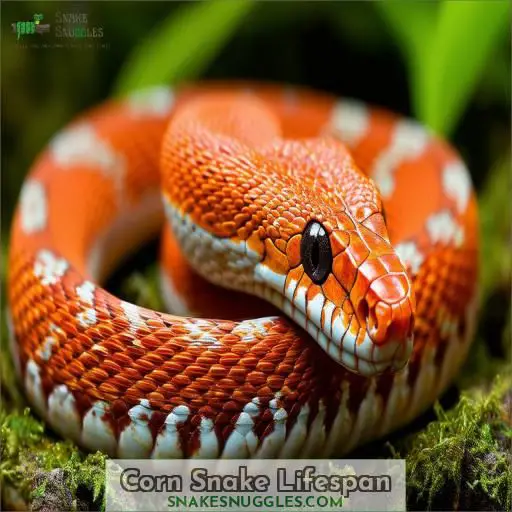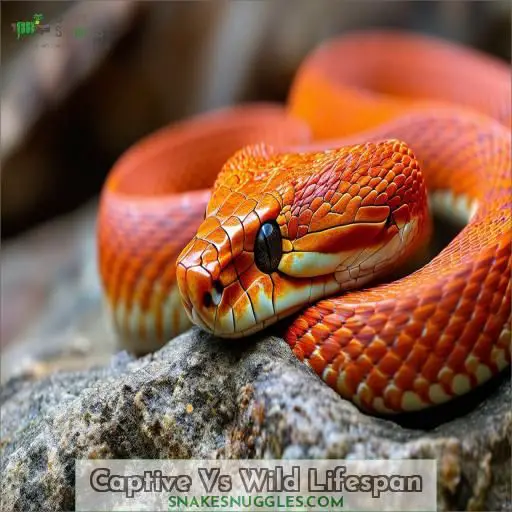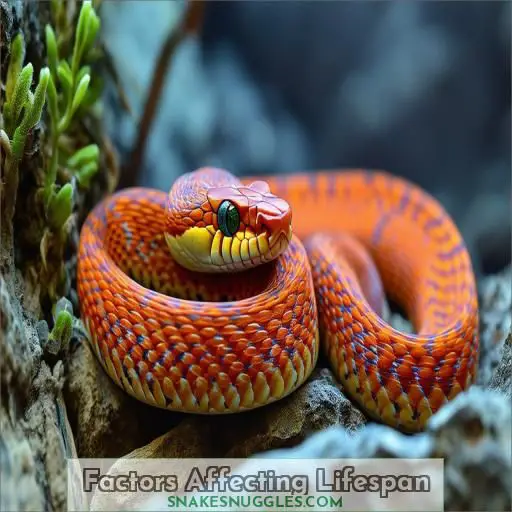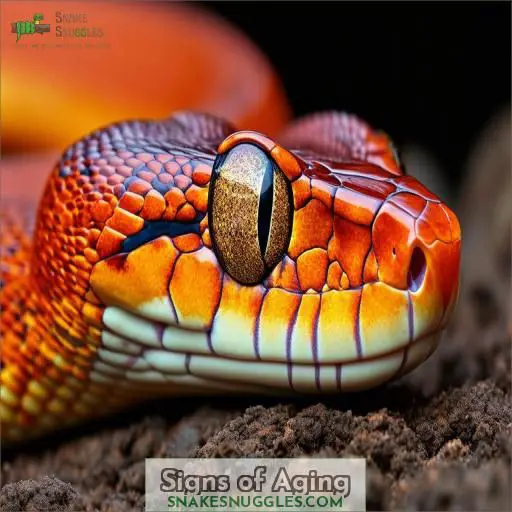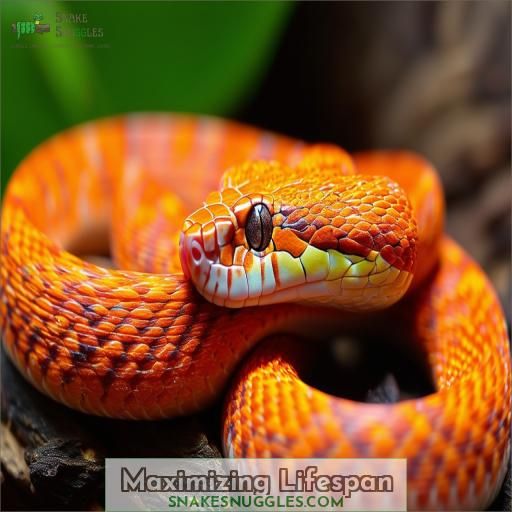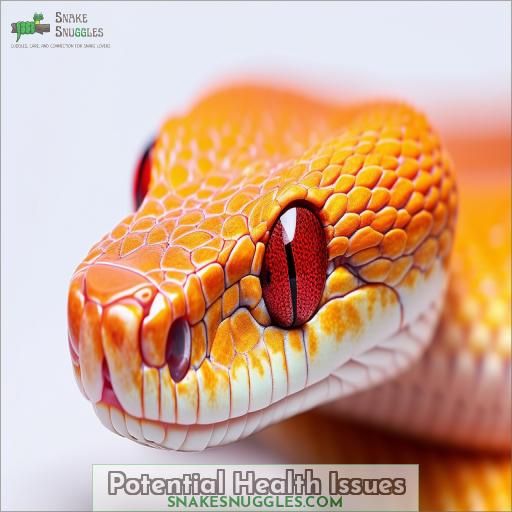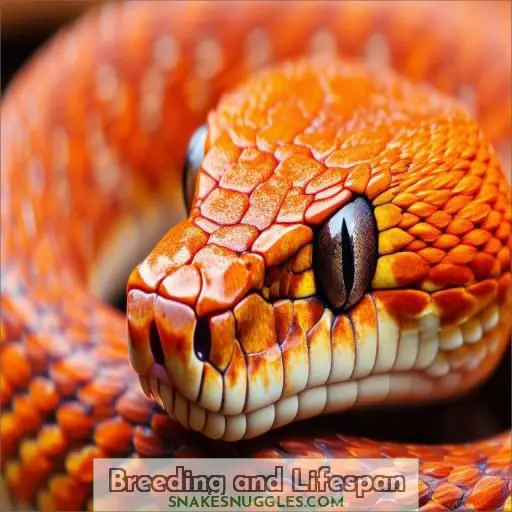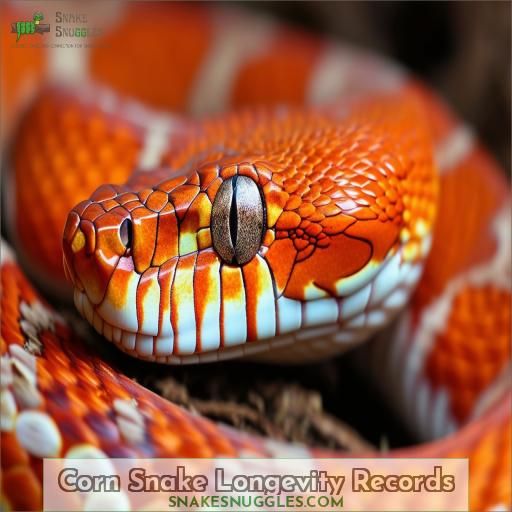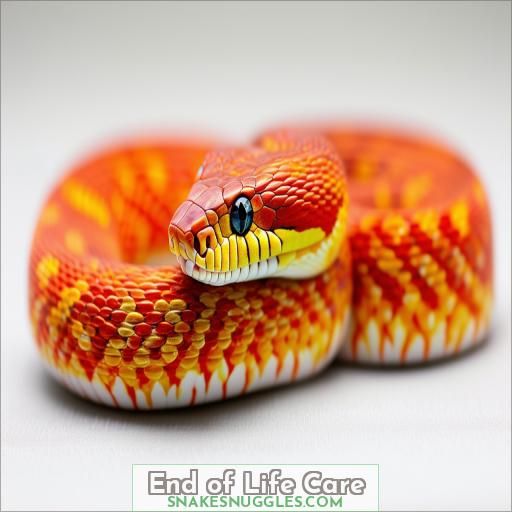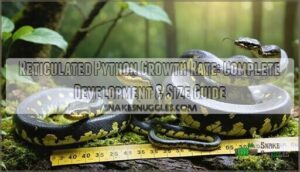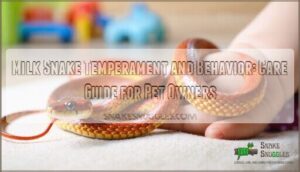This site is supported by our readers. We may earn a commission, at no cost to you, if you purchase through links.
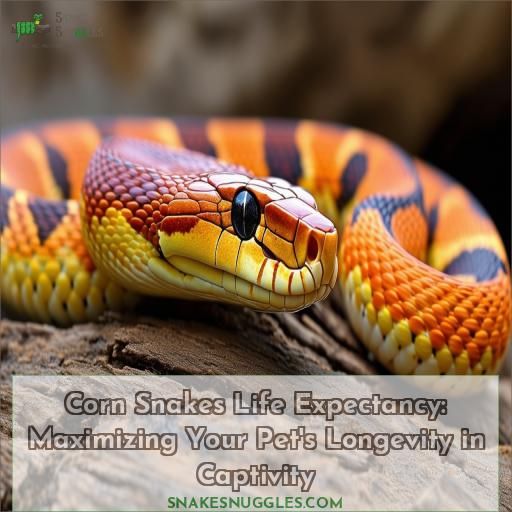 In captivity, corn snakes can live an impressive 15-20 years with proper care.
In captivity, corn snakes can live an impressive 15-20 years with proper care.
You’ll maximize your pet’s longevity by replicating their ideal environment: a spacious enclosure with warm basking spots, cool retreats, and regulated humidity.
A varied diet of appropriately sized rodents provides essential nutrients.
Minimize stress through gentle handling and monitoring for signs of illness.
While genetics plays a role, you can greatly influence your corn snake’s lifespan by controlling environmental factors.
Ready to learn the key elements for keeping your scaly friend happy and thriving for decades? Let’s explore.
Table Of Contents
Key Takeaways
- With patience and TLC worthy of a reptilian retiree, these charming corn snakes can slither past the ripe old age of 20 in captivity – talk about one heck of a snakey centenarian!
- It’s the little things that add up to a long life for your scaly pal – a well-appointed vivarium mimicking their natural habitat, a sumptuously varied rodent-based buffet, and plenty of low-stress snuggles to keep them feeling secure.
- While genetics plays its part, you’re the real VIP when it comes to extending your corn snake’s longevity. Treat them like royalty with that premium husbandry, and they’ll be hanging around for grandkid #3’s high school graduation.
- As they enter their golden years, be prepared to adapt and pamper your elder statessnake – maybe an orthopedic branch for basking or a senior rodent discount? Hey, they’ve earned those reptilian retirement benefits!
How Long Do Corn Snakes Live in Captivity?
Corn snakes can live for a long time in captivity, typically between 15 to 20 years with proper care. However, some well-cared-for corn snakes have been known to live up to 30 years or more in captive environments.
Corn Snake Lifespan
Your corn snake’s lifespan can vary greatly depending on factors like diet, habitat, and genetics.
While they may live 6-8 years in the wild, captive corn snakes have been known to reach ages over 20 years with proper care!
Understanding their natural life cycle and age-related behaviors is key to maximizing longevity.
Research on corn snake longevity provides insights for conservation efforts and highlights the impact environmental conditions have on these remarkable reptiles.
As a responsible pet owner, you play a crucial role in ensuring your corn snake thrives for years to come.
Captive Vs Wild Lifespan
You’ve learned about corn snakes’ typical lifespans, but did you know these charming reptiles can live much longer in captivity? While they may survive 6-8 years in the wild, captive corn snakes (Pantherophis guttatus) often reach 15-20 years with proper care. Some key factors contribute to this lifespan extension:
- Controlled environment
- Favorable temperatures
- Lack of predators
With their smaller wild sizes capping out around 5 feet, captive specimens frequently exceed 6 feet due to abundant food and ideal housing. By replicating corn snakes’ preferred conditions, you provide the foundations for maximum longevity in your scaly companion.
Factors Affecting Lifespan
You can prolong your corn snake’s lifespan by providing a well-balanced diet, suitable habitat, proper handling, and considering genetics. A varied diet of appropriately sized rodents, a spacious and well-maintained enclosure with proper temperatures and humidity levels, gentle handling to minimize stress, and selecting from quality genetic stock play essential roles in fostering longevity for your pet corn snake.
Diet
Offer a varied diet of properly sized, whole prey—no bigger than the snake’s widest part. Appropriate feeding frequency prevents obesity or nutritional deficiencies.
Habitat
Improper habitat can shorten lifespan. Make certain vivarium has:
- Appropriate substrate
- Proper lighting
- Hidingspots
- Climbing structures
Maintaining ideal humidity levels also boosts longevity. Snakes housed correctly live much longer.
Handling
Proper handling techniques reduce stress, allow bonding, prevent bites. Socialize snakes through regular, gentle interaction. Never grab or squeeze.
Genetics
Genetics plays an important role in a corn snake’s lifespan. Consider these factors:
- Genetic predisposition to longevity
- Effects of inbreeding depression
- Genome mapping for healthier breeding
- Selective breeding for desirable traits
Signs of Aging
As your corn snake ages, you’ll notice signs like decreased activity, reduced appetite, and dull skin and eyes. Monitor for lumps or swellings that could indicate underlying health issues. The aging process varies, but here’s a general guideline:
| Age Range | Signs |
|---|---|
| 1-5 years | Vibrant, active |
| 6-10 years | Slowing down |
| 11-15 years | Less mobile, may refuse food |
| 16+ years | Geriatric, potential organ failure |
Don’t panic if your senior snake exhibits these changes gradually – proper care can extend their life notably. Stay observant and adjust their environment and diet as needed for their comfort.
Maximizing Lifespan
To maximize your corn snake’s lifespan in captivity, provide an enclosure with the proper temperature gradient, ranging from 80-85°F on the warm end to 75-80°F on the cool end. Maintaining appropriate humidity levels between 40-60% and offering a balanced, rodent-based diet are also essential for prolonging your pet’s life expectancy.
Proper Housing
Proper housing mimics their natural habitat. Provide an appropriately sized enclosure with temperature gradient, suitable substrate, and multiple hide options for thermoregulation and security.
Ideal Temperature
Maintaining a suitable temperature is essential for your corn snake’s well-being. Provide:
- Warm basking area (85-90°F)
- Cool end (75-80°F)
- Temperature gradient
This thermal regulation supports good health.
Humidity Levels
maintaining proper humidity levels within your snake’s enclosure. You’ll want to closely monitor and regulate the humidity, keeping it between 40-60% at all times.
Nutrition
You’d feed corn snakes frozen mice/rats thawed to body temperature. A varied Rodent diet helps mimic feeding habits seen in nature for healthier reptile pets.
Potential Health Issues
Like many captive reptiles, corn snakes can develop respiratory infections, parasites, mouth rot, and shedding problems if not properly cared for. Providing the appropriate habitat conditions, diet, and monitoring for early signs of illness is essential to avoid these health issues and support the well-being of your corn snake.
Respiratory Infections
You’ll notice respiratory infections by wheezing, open-mouth breathing. Prevent them with proper temps, humidity. Treat with reptile-safe antibiotics if caught early.
Parasites
Another health concern is parasites. You’ll want to watch for:
- Lethargy
- Weight loss
- Lack of appetite
- Irregular fecal matter
Early detection and treatment are essential for your corn snake’s wellbeing.
Mouth Rot
Mouth rot causes swelling, pus, reddening around the mouth. It’s caused by bacteria from poor husbandry. Antibiotics treat infections. Quarantine affected snakes. Improve cage hygiene prevents recurrence.
Shedding Problems
Another potential health issue: improper shedding cycles. An incomplete shed can signal:
- Dehydration
- Low humidity
- Unshed eye caps
- Infection risk
- Need for shedding aid
Ensuring the right environment prevents shedding problems.
Breeding and Lifespan
You may wonder about breeding and its effect on your corn snake’s lifespan.
The breeding schedule impacts longevity – females typically breed every 2-3 years after reaching maturity around age 3.
Proper breeding preparation and post-egg care is essential to avoid stress that shortens lifespan.
Notably, offspring longevity isn’t directly tied to parental age.
With ideal care, captive-bred corn snakes can live as long as their wild counterparts.
Ultimately, breeding responsibly by following expert guidelines guarantees your snake’s well-being and maximizes its lifespan.
Corn Snake Longevity Records
Speaking of longevity records, you may be curious about the real golden oldies among corn snakes. While a typical lifespan is 10-15 years, some captive specimens have truly pushed the limits:
- Longest recorded: 32 years, 3 months
- Several cases over 25 years documented
- Males tend to outlive females on average
- Genetic lineage plays a role in exceptional cases
Achieving such an impressive age requires impeccable care from an experienced keeper. With diligence, you too could witness your corn snake’s lifespan stretch far beyond norms. But longevity isn’t everything – quality of life matters just as much.
End of Life Care
While your corn snake’s end nears, prioritize comfort and dignity. Consider hospice or palliative care to minimize suffering. Veterinarians offer humane euthanasia options if quality of life diminishes. Manage pain with medication and gentle handling. For final arrangements, choose burial or cremation based on personal values.
| Option | Pros | Cons |
|---|---|---|
| Burial | Eco-friendly, sentimental | Legality concerns in some areas |
| Cremation | Convenient, affordable | Less personal connection |
| Bio Cremation | Environmentally safer | Relatively new, limited availability |
Cherish the memories. Celebrate your snake’s life while easing their passage with compassion. Their legacy lives on through your nurturing care.
Frequently Asked Questions (FAQs)
How long does a corn snake live as a pet?
As the saying goes, "Patience is a virtue" – with proper care, corn snakes can live over 20 years in captivity. Providing an appropriate habitat with the right temperature, humidity, and diet guarantees these fascinating pets thrive for decades.
Are corn snakes happy in captivity?
Yes, corn snakes can thrive in captivity when their basic needs are met – proper habitat, diet, and handling. With the right environment and care, they remain active and content as pets.
How do I know if my corn snake is happy?
A happy corn snake has bright eyes, smooth shed skin, and responds calmly when handled properly. It actively explores its enclosure, eats regularly, and doesn’t nose-rub or strike the glass.
Do corn snakes want to be held?
Corn snakes aren’t typically lap pets, but gentle handling is enriching. Offer hiding spots so your snake feels secure during out-of-enclosure time. Short sessions prevent stress from over-handling.
How often should corn snakes be handled?
Like a metronome keeping time, handle corn snakes regularly yet gently. Aim for 10-15 minutes weekly, avoiding stressful situations that could prompt defensive bites. Proper handling builds trust with your scaly companion.
What is the ideal enclosure size?
You’ll want an enclosure around 2/3 the length of your corn snake. This gives them enough room to move freely without feeling cramped. Maintain proper temperatures, humidity, and decor for their well-being.
How do you introduce new prey items?
Much like exploring a new trail, introduce new prey gradually. Scent it first, then dangle it cautiously before leaving overnight. With time and patience, your corn snake will happily forge ahead on this new culinary adventure.
Do corn snakes recognize their owners?
Yes, corn snakes can recognize their owners through voice, scent, and regular positive interactions. With patience and proper handling, they’ll learn you’re not a threat and may even become quite tame.
Conclusion
Visualize a healthy corn snake thriving for 20 years under your care.
By adhering to proper husbandry guidelines, you can maximize your pet’s longevity in captivity.
Providing a spacious, well-regulated habitat, a varied diet of appropriately sized prey items, and minimizing stress through gentle handling are key factors.
With dedication and knowledge, you can guarantee your corn snake enjoys a long, fulfilling life as a cherished companion.

